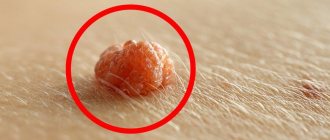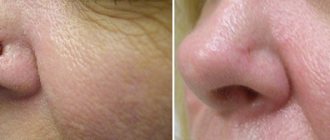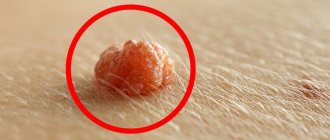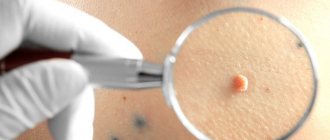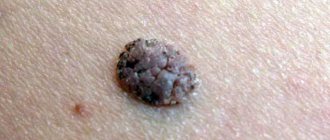Today you rarely meet a person with perfect skin without a single tumor. According to statistics, 70% of the population is infected to varying degrees with the human papillomavirus (HPV). Any growths on the skin cause unpleasant emotions, painful sensations or simply discomfort, both psychological and physical, which interferes with leading a full life.
Cost of services in our clinic
| Appointment with a dermatologist, candidate of medical sciences | 1500 rub. |
| Consultation with a dermatologist (KMS) when removing 2 tumors | 0 rub. |
| Removal of a neoplasm (wart, mole) using the radio wave method | 500 rub. |
| Make an appointment by phone: 8-800-707-15-60 (toll-free) |
| *The clinic is licensed to remove tumors |
Warts and papillomas are the most common manifestations of the human papillomavirus. Due to their common nature, they have many similarities, but there are also many differences between them. Initially, warts and papillomas appear on the body as benign formations, but some of them, under certain conditions, can degenerate into a malignant form. This necessitates their removal not only for aesthetic reasons.
What are warts
The content of the article
Warts are rounded elevations of the skin in the form of a papilla or nodule with clear contours and a dense structure, arising due to the active growth of the upper layers of the epithelium. They can appear in absolutely every person, at any age and on any part of the skin, from the head to the soles of the feet. The most common “targets” are exposed areas of the body that are often subject to injury: arms, elbows, knees, head. Warts can reach sizes from 1 mm to 15 mm: this directly depends on its type and location of formation. They are located on the body singly or in small groups, and their distribution depends on the functioning of the immune system. There is also a rapid increase in the number of growths when the integrity of the wart is damaged. Sometimes several warts merge, forming a large tumor with a wide base in the form of a cone or hemisphere. When they appear, the growths are flesh-colored, and over time they can acquire a brown or even black tint, sometimes gray or yellowish. Their surface can be smooth, slightly rough or pimply. Outwardly, they resemble acne or calluses, so they are quite easy to confuse. A feature of warts is the high probability of spontaneous remission, especially if they arose in childhood.
Which doctor treats papillomas and where is the best place to remove papillomas on the body in St. Petersburg?
Many patients are interested in which doctor treats papillomas. This is done by specialists - dermatologists, gynecologists, urologists and oncologists. It all depends on the location of the tumor.
Specialists at the Diana Clinic in St. Petersburg conduct an initial examination and confirm the diagnosis. Then the papillomas are removed with a laser and radio knife, using the latest devices. By contacting our medical center, the patient receives a detailed consultation and can undergo all tests, including oncology. Removal of papillomas is carried out without pain or complications.
What are papillomas
Papillomas are also benign formations. They come in a variety of shapes - leaf-shaped, spherical, filamentous or lobed, often resembling cauliflower in appearance. The growths have a soft, loose structure and are located on a thin stalk. Initially, their size is about 2 mm, but gradually they are able to grow up to 1-2 cm. The color of papillomas also varies from white to dark brown. The favorite location is areas of the body with thin and delicate skin, folds and mucous membranes, i.e. these are the neck, eyelids, nasolabial fold, armpits, area under the mammary glands, genitals, groin area, perianal fold, around the anus, in the rectum, urethra, bladder, etc. Quite rarely, papillomas can form in the oral cavity and on the vocal cords. The growth can be either single or multiple. Basically, there are 5-20 papillomas in one area. Their prevalence largely depends on the immune system and its ability to resist the virus. The main feature of this type of neoplasm is the increased threat of transition to a malignant form. This is especially true for papillomas that form on the mucous membranes of the female genital organs. If left untreated, they cause cancer.
Questions and answers on removing papillomas
For all answers to questions , see the FAQ section.
- Warts
- Methodology
- Equipment
- Papillomas
- Indications
- Recommendations
- Moles
- Price
- Grinding
- Pregnancy
- Age
- A tan
- Infection
- Number of procedures
- Collost
- Cosmetic seam
- Lactation
- Anesthesia
- Restrictions
- Oncology
- results
- Eyelid
- Wine stains
- Ingrown nail
- Histology
- Zhiroviki
- Molluscum contagiosum
- Face
- Calluses
- Papillomas
- Dark spots
- Stretch marks
- Scar
- Striae
- Tattoo
- Acne
- Scars
Collapse answers
— Is it possible to remove papillomas of the external genitalia during pregnancy? Which method is safe at this time?
Olga
Answers Kopylova Irina Yuryevna, cosmetologist-surgeon, for 13 years - During pregnancy, all manipulations are carried out according to strict indications. Your obstetrician-gynecologist must make the necessary appointments for you.— I would like to remove a papilloma on the body, the area is about 1 square. see: Is a preliminary examination necessary? I visited an oncologist at the district clinic - he said it was an ordinary papilloma, he offered to remove it himself, I suppose with a scalpel, but he refused. How long does the procedure take? Focus on cost.
Inga
Answered by Markova Irina Vyacheslavovna, a cosmetologist-surgeon for 11 years - Laser removal of skin formations, including papillomas - the procedure is outpatient, performed under local anesthesia, the duration of removal is several minutes. Before removal, a consultation with a doctor is required, the cost of which is counted when calculating the cost of papilloma removal on the day of treatment. The removed material can be sent for histology for a fee to examine the malignancy of the formation. The cost of removal depends on the area - face or body, on the size of the papilloma in millimeters and the number of papillomas removed at the same time. Anesthesia is paid additionally.— Do you remove papillomas on the face? Will there be a scar? Can this be done on the day of treatment, do I need to make an appointment?
Olesya
Answers Irina Vyacheslavovna Markova, a cosmetologist-surgeon who has been working in Rednor centers for 11 years When removing papilloma with a laser, there will be no scar left. We work by appointment only. In the absence of contraindications, removal can be performed on the day of treatment.
Discount program for our clients.
A discount system is provided for our clients, allowing them to receive services from the Rednor Cosmetology Centers at discounts. Depending on the number of services received, you can receive a discount card for 5%, 10% and 15% .
How to get a discount card for Rednor Cosmetology Centers?
1. A 5% discount card can be obtained after the first visit and payment for the first service (except for consultation). Card discounts are provided on services from the next visit.
2. A 10% discount card can be obtained after a one-time payment for services costing from 10,000 rubles. A 10% discount on the card is available from your next visit.
3. A 15% discount card is provided to clients who invited their 3 or more friends to use the services of the Rednor Cosmetology Centers. This card, which gives the right to receive a 15% discount, is personalized, and upon presentation, an identification document may be required. The right to a 15% discount on a personalized card cannot be transferred to others . If you want to get a 15% discount card - read the details
Causes of warts and papillomas
The appearance of warts and papillomas is a consequence of the human papillomavirus (HPV) entering the body. And the well-known theory that warts appear from touching a frog is just a misconception. You can become infected with papillomavirus in several ways:
- sexually;
- during childbirth;
- contact and household.
- Speaking in more detail about the household contact method, we can highlight the following ways of infection entering the body:
- direct skin contact (handshake, kiss);
- through objects of common use (in the gym, in transport);
- when using personal items (razor, toothbrush);
- wearing someone else's shoes, walking barefoot in public places (baths, swimming pools, etc.);
- when carrying out cosmetic procedures with instruments that have not been disinfected (epilation, manicure).
The virus penetrates through microcracks, cuts or abrasions on the skin. After penetration, the pathogen goes into standby mode and is activated under certain conditions. That is why there is no exact definition of the incubation period of HPV. In people with a strong immune system, neoplasms do not form; the pathogen is destroyed and eliminated from the body within a year. The following factors can “activate” the virus and thereby cause the growth of warts and papillomas:
- infectious diseases that weaken the immune system;
- stressful situations and nervous overstrain;
- pregnancy;
- obesity;
- decreased immunity;
- undergoing chemotherapy;
- avitaminosis;
- diabetes;
- hormonal imbalance;
- heavy and prolonged physical activity;
- lack of hygiene;
- bad habits;
- diseases of the gastrointestinal tract;
- long-term use of antibiotics that suppress the immune system.
Older people and children are most likely to become infected with the virus. This is due to the condition of the skin in this age category. Genetic predisposition also influences HPV susceptibility to some extent.
Differences and similarities between warts and papillomas
It is often difficult to distinguish a wart from a papilloma, since they are very similar to each other. In some cases, it is difficult even for a dermatologist to do this during a visual examination. Warts and papillomas have the following common features:
- formation on the surface of the epithelium;
- the nature of the neoplasms is viral: they develop due to the entry of the human papillomavirus into the body;
- the initial character is benign;
- under certain conditions they can become malignant;
- may cause itching, irritation, swelling of nearby tissues;
- have blood vessels, so they bleed when injured;
- education and development are affected by the state of the immune system;
- After removal there is a risk of relapse.
How does HPV infection occur?
The mechanism of transmission of the virus is contact; the source of infection is the patient or the virus carrier. HPV can be released not only from growths on the skin, but also circulate in the blood, saliva and urine. In this case, infection can occur in 4 main ways:
- through contact and everyday life;
- sexually;
- during childbirth from mother to child (which may be the cause of laryngeal papillomatosis);
- during autoinoculation (self-infection or dispersion of the pathogen from existing foci during combing, shaving, or using a hard washcloth).
The risk of HPV infection usually depends on the state of the human body’s immune system, viral load and the presence of microtraumas and other inflammations on the skin and mucous membranes.
Even when infected with the HPV virus, papillomas do not always form on the skin and mucous membranes. The virus is localized in the basal layer of the epithelium and can remain inactive for a long time. Only under certain conditions (weakening of the immune system, stress, exposure to unfavorable environmental factors) do the processes of its replication start, which leads to cell proliferation and the appearance of tumors.
Despite many similarities, neoplasms have an impressive list of differences
| Index | Warts | Papillomas |
| Form | Mostly round with clear contours | Mostly leaf-shaped or lobed with fuzzy, ragged contours, looks like cauliflower |
| Color | From flesh to light brown, sometimes pink, can even acquire a black tint due to the accumulation of dirt | White to dark brown |
| Localization | On open areas of the body: arms, legs, scalp, etc. | In folds and mucous membranes: armpits, genitals, neck, face, etc. |
| Structure | Dense | Soft |
| Fastening | Wide base | "Leg" |
| Size | Capable of shrinking and growing | Only increasing |
| Peculiarity | Capable of self-destruction without treatment | Do not disappear on their own, must be removed |
| Treatment | Removal, possibly drug treatment | Delete only |
| Tendency to malignancy | Almost never reborn | High probability of transition |
When should papillomas be removed?
The presence of papillomas in itself does not threaten health. In most cases, papillomas cause more aesthetic discomfort.
In rare cases, papillomas degenerate into malignant formations, and that is why experts recommend removing papillomas immediately.
It is necessary to remove papillomas if:
1. The papilloma is in an awkward place and constantly rubs against clothes. Constant physical contact of papilloma and clothing can provoke the degeneration of papilloma into a malignant tumor.
2. Papilloma causes pain when pressed or any other physical impact.
3. If papillomas are located on open areas of the skin (for example, on the face)
4. On doctor's recommendation
What happens after laser removal of papillomas and other tumors?
For the first two to four weeks, redness of the skin will be observed in the laser treatment area, which will subside over time. For this period of time, it is recommended to refrain from sunbathing, visiting swimming pools and baths, and also to carefully monitor that the wounds do not have any physical impact (for example, after a shower, do not rub the wounds with a towel but dry them with a hairdryer).
Treatment of the patient consists of strictly following all doctor’s recommendations and may include drug antiviral therapy.
Types of warts
Today there are over 100 types of HPV, each of which gives rise to a certain type of warts and papillomas. The incubation period is about 2-6 months, but it largely depends on the human immune system: a strong and healthy body easily fights the occurrence and proliferation of growths. The following types of warts are distinguished:
- ordinary (simple, vulgar);
- plantar (pinuses);
- flat (juvenile);
- senile (age-related keratomas).
Ordinary (simple, vulgar) - warts in the form of small dense dry nodules with an uneven and rough surface, variable sizes and a rounded shape. They do not cause itching, pain or discomfort. Simple warts reach from 3 to 10 mm in diameter. They are usually flesh-colored, sometimes pink, yellowish, or light brown. Due to the accumulation of contaminants in the porous surface, they can turn dirty gray. The favorite localization of simple warts is the back of the hands and fingers. Sometimes they are observed on the knees and elbows, rarely on the face and feet. After some time (it’s different for everyone), the tumor increases in size, and the skin in its place begins to peel off. The progression of the pathology is manifested by the formation of a large “mother” wart with a scattering of small ones around. When removed, small ones usually self-destruct over time. Plantar warts (spikes) are warts in the form of several fused nodules with a roll of keratinized skin around them. Inside the growths, many small black dots are visible - thrombosed capillaries. Plantar warts are round in shape, rise above the skin by 1-2 mm and can reach up to 2 cm in diameter. However, 75% of the tumor is located in the deep layers of the epithelium, so their main feature is inward growth. Outwardly, these warts resemble calluses, which is why they are often confused with each other. It's important to remember that, unlike a callus, a ring of dead skin forms around a wart. Spines are localized on the feet, rarely on the palms. Usually colored yellow or dark brown. This type of wart causes significant discomfort, itching and pain, aggravated by walking, and may even bleed. In 50% of cases it self-destructs without treatment, but this may take from 8 to 18 months. As the pathology progresses, the number and size of warts will increase, which may lead to the inability to walk due to unbearable pain. Flat (juvenile) - warts in the form of small flat papules with a smooth (sometimes scaly) surface, slightly raised above the surface of the skin. Traditionally it affects people aged 10 to 25 years. They are formed in multiple clusters or singly, which is quite rare. Usually the growths are flesh-colored, sometimes white, brown, yellowish or pink. They appear on the face, neck, knees, elbows, back, legs and arms (especially on the fingers and back of the hands), sometimes on the head of the penis. As a rule, they are painless and do not cause discomfort unless they are subjected to mechanical pressure or damage. Flat warts can suddenly disappear on their own just as they appeared, especially in childhood. But sometimes they are quite difficult to treat. Senile (seborrheic keratoses) are warts in the form of dark, flat, round or oval plaques that appear in old age. They reach a diameter of 0.2-3 cm, sometimes 4-6 cm. The pathogenesis is not clear, but their appearance is definitely not associated with HPV. Senile warts can affect any part of the body except the palms, soles of the feet, and mucous membranes. As a rule, they appear in multiple clusters (about 20 foci). Initially, they appear as small light brown spots or papules with clear contours. Over time, keratoses may retain their appearance and resemble freckles, or they may harden, forming a warty surface covered with easily removable thin crusts. In most cases, senile warts take on a mushroom shape and are dark brown or black in color. They develop very slowly, over decades, never degenerating into a malignant form. Typically, seborrheic keratoses are removed for aesthetic reasons or because they become itchy and irritating. If the growths, especially large and warty ones, are injured (rubbed against clothing, touched by something), they may bleed or become inflamed.
Causes of intranasal papilloma
Papilloma is a benign tumor that affects both the weaker and stronger sexes, mainly after 50 years. Papilloma can cause a lot of discomfort
mouth, because it reminds you of itching, burning and slight discharge.
What does papilloma in the nose mean???
The main cause of nasal papilloma is infection with the papilloma virus. The virus can remain silent about its existence for many years. Only on favorable terms, for example. With reduced immunity, it will remind itself of itself in the form of “warts”.
There can be many reasons for the appearance of this virus. Various predisposing factors work together to cause the appearance and growth of many human tumors.
Causes of papilloma:
- Weakened immunity;
- Change sexual partners frequently;
- Visit public entertainment venues - swimming pools, baths, saunas;
- Damage to the central nervous system;
- Long-term drug use;
- Smoking, excessive alcohol consumption.
Winter and spring are not the most favorable times for our immunity. During this period, it is useful to take several vitamins to increase the body's defenses.
The growth of by-products is very slow. At first, the person may not realize the danger. Papilloma in the nasal cavity gradually disrupts nasal breathing, causing very serious discomfort.
Remember that if there is congestion in the nose, you should immediately consult a specialist. As papilloma grows and develops, surrounding tissues are destroyed. If not intervened in time, warts will grow over the spenoid sinus cavity, cranial cavity, or orbital cavity.
How to get rid of it?
It is naive to expect that papilloma will leave the olfactory organs on its own. There are at least two reasons why a person needs to get rid of nasal growth:
- Papilloma can develop into a malignant neoplasm.
- Warts make breathing very difficult and cause a lot of discomfort to the owner.
In most cases, the patient is offered surgery to remove papilloma from the nose. The procedure is virtually risk-free and completely painless.
There are several ways to remove papillomas in the nose:
- Open surgery. The recovery period after surgery is very long, since the surgeon will open the nasal cavity. Surgery is very rare.
- Endoscopic intervention. The endoscope is inserted into the nasal cavity. This allows the doctor to visually monitor all his movements. Endoscopic intervention is the most effective and fastest way to remove papilloma, since the recovery period is reduced to the minimum possible time.
- Laser removal. Subnasal papilloma is the main attraction using lasers to remove sediment. The procedure is painless, but can be carried out in several stages. The main advantage is that it does not bleed. Major disadvantages Not recommended for severe tissue damage.
If a patient notices that the papillomavirus has recently begun to progress, it is not too late to seek medication. However, you should not choose medications on your own.
The recovery period varies from person to person, but generally after a week the patient is discharged and sent to a family hospital (if necessary). During the recovery period, it is important to take care of your health by eating well and taking intensive medications.
Precautionary measures
Removing nasal papilloma is much more difficult than preventing its occurrence. No one can prevent the papilloma virus from spreading on his body. However, this is not a reason to ignore preventive measures.
What to remember?
- Follow the rules of personal hygiene.
- Increased body protection in case of damage.
- To eat well.
- Avoid intimacy without condoms.
- Timely treatment of neurological diseases.
It doesn't matter where the papilloma is located. It is important for people infected with this virus to see a doctor promptly. Your doctor will determine your HPV type and recommend appropriate treatment. Good health!
Types of papillomas
- The following types of papillomas are distinguished:
- filamentous (acrochords);
- anogenital.
Anogenital (genital condylomas) - papillomas in the form of flesh-colored or pale pink growths of an acute shape, prone to fusion. When rubbed, they become crimson and begin to bleed. Such growths reach 1-1.5 cm and in appearance they resemble cauliflower or cockscomb due to their lobed structure. They are usually transmitted sexually and have a specific localization: on the genitals, in the perineum, on the walls of the vagina, on the foreskin, scrotum and around the anus. Although with less frequency, even in the absence of anal sexual intercourse, they can even grow in the anus and urethra, causing bleeding and discomfort during bowel movements. If the virus enters the body through oral sex, then warts appear on the mucous membrane of the oral cavity, in the pharynx, on the vocal cords or trachea. Sometimes they can form in the armpits, under the mammary glands, and in children - in the nasolabial folds. Anogenital papillomas are quite dangerous for humans for many reasons, the main one of which is the high probability of degeneration into a malignant form. Being inside a woman's vagina, they cause itching and burning, pain in the lower abdomen, pain and discomfort during sexual intercourse, and after it - spotting. Therefore, regardless of position, shape and size, genital warts should always be removed. Filiform - neoplasms in the form of thin, long, racemose shoots. They are also called facial because they are usually localized on the face, especially the eyelids and nasolabial folds, and neck. Rarely they can occur on the legs, in the groin folds, under the mammary glands and in the armpits. Those. they appear in areas of delicate and thin skin, in folds characterized by high humidity. It mainly affects older people. The process of formation of a growth begins with the appearance of a small nodule; over time, the formation acquires an elongated oval shape or remains round on a thin stalk. Traditionally, thread-like growths are flesh-colored, which is why they often go unnoticed for a long time, but sometimes they become yellow, brown or pink. They grow about 0.5-1 cm, exceeding that is extremely rare. The risk of acrochords degenerating into a malignant form is minimal, but if they are injured, an inflammatory process may develop. This type of neoplasm does not self-destruct and is prone to spreading to other parts of the body and increasing in size and number. For most people, this causes psychological discomfort, emotional stress and decreased self-esteem. Therefore, a cosmetic defect is the main reason for removing filamentous growths.
Variety of papillomas: 7 main types
Scientists know more than 100 types of HPV, but the most common are 10 types of papillomas:
- Plantar papillomas
. Causes papilloma on the leg - papillomavirus types 1, 2, 4. Plantar papillomas look like growths on the soles of the feet. Plantar warts can be single or multiple. Over time, it becomes painful for a person affected by the disease to walk. Plantar papilloma is often confused with a callus and is not sought medical attention, while the infection affects new areas of the skin. - Vulgar papillomas
. These are oval, keratinized lumps with a yellowish tint, usually appearing on the hands of adults. In children, such tumors can be found on the knees. - Flat papillomas
. The result of activation of HPV types 3, 10. The growths look like flat, smooth bumps. - Lewandowski-Lutz papillomas . The second name is epidermodysplasia verruciformis. The infection results in the formation of many mottled, multi-colored warts on the arms and legs.
- Filiform papillomas. Formed in older people. Warts look like yellowish bumps. Placed on the eyelids, groins, armpits, and neck. Threaded papilloma injured by clothing or as a result of scratching requires urgent treatment, otherwise inflammation and complications cannot be avoided.
- Juvenile papillomas . Associated with infection with papillomavirus types 6, 11. Formed in the larynx. As a result, breathing becomes difficult and speech deteriorates. The virus spreads during childbirth, transmitted to the newborn from the mother.
- Genital warts . The occurrence of genital warts is the main manifestation of infection, the source of which was the human papillomavirus. Visually, genital warts look like ordinary warts, can be small in size (up to a centimeter), have a flesh-colored or pinkish color, a slightly bumpy or completely smooth surface. The most common place for the formation of genital warts is the external genitalia. In men, these formations appear on the scrotum and penis. In women - on the labia majora and minora, on the cervix, near the clitoris, in the vagina. If condylomas are irritated, itching and bleeding may occur during sexual intercourse. Such papillomas transform into cancerous tumors.
Why are neoplasms dangerous?
The main danger that warts and papillomas pose is the threat of degeneration into a malignant form. The degree of their danger depends on the type of papillomavirus:
- high (oncogenic) – 16, 18, 31, 33, 35, 39, 45, 52, 58, 59, 68;
- low (non-oncogenic) – 6, 11, 26, 41, 42, 50, 61, 73, 82, etc.;
- absent – 1, 2, 3, 4, 5.
There is a high probability of malignancy if warts and papillomas are constantly injured (rubbed against clothing, touched by something, etc.). In this case, infection with harmful bacteria may occur. To prevent the degeneration of a benign tumor into a malignant one, it is necessary to regularly visit a dermatologist and not hesitate to detect suspicious symptoms. Particularly dangerous are genital warts that affect the internal genital organs of a woman, since they can cause serious diseases: pseudo-erosion of the cervix, ectopia of the columnar epithelium, and cervical cancer. In addition, their presence is manifested by a number of unpleasant symptoms: burning and itching in the vagina, unpleasant odor, pain in the lower abdomen, pain and discharge of ichor during sexual intercourse. In men, the lack of treatment for papillomas leads to decreased libido, erectile dysfunction, and infertility. It can also provoke dangerous diseases: adenocarcinoma, anal cancer, diseases of the penis, oral cavity or larynx.
Many varieties are not dangerous, but ignoring the treatment of warts and papillomas will provoke an increase in their number. And the constant attack of the body by viruses will ultimately lead to a deterioration in the overall health of a person.
How dangerous are papillomas on the body: why they need to be removed
Papillomas are harmless only in appearance. These neoplasms, in the absence of timely and adequate treatment, quickly spread throughout the body to healthy tissue. This process is called autoinaculation. The result of the proliferation of neoplasms is at least multiple warts.
Of course, warts - papillomas on the body - are very ugly, but this is not the only problem. A good dermatologist will tell you why papillomas on the body are dangerous - such neoplasms are susceptible to melanization - malignant degeneration of the tumor. How quickly the process will proceed and whether it will begin at all depends on the location of the papilloma and the type of HPV. Genital warts growing on the cervix are especially dangerous. The degeneration of such formations into cancer occurs in every second case.
The structures that form on the skin as a result of damage by the papilloma virus are usually not accompanied by pain, itching or burning, which often causes negligence on the part of the patient. But since papillomas almost always come into contact with clothing, there is a high risk of damage. The result will be severe bleeding, infection and the formation of unsightly scars on the skin. From all this follows the answer to the question of whether it is necessary to remove papillomas on the body - of course it is necessary!
Diagnostics
It is extremely important to correctly determine the type of tumor, taking into account oncogenicity and external similarity. Initially, the doctor conducts a clinical examination of the growth, if located on the genital organs - gynecological in women, proctological and urological in men. This is not enough to make an accurate diagnosis. To establish a reliable clinical picture, it is recommended to conduct research at the cellular level using special diagnostic methods, namely:
- cytological examination of cell morphology - to identify DNA mutations;
- colposcopy - examination of the vulva, vagina and cervix using a special microscope - colposcope;
- biopsy - sampling of cells and tissues for the purpose of diagnosing the pathogen;
- histology - a type of biopsy - to determine a precancerous condition;
- polymerase chain reaction (PCR) techniques - to identify all types of virus;
- Digene test. It is the most reliable and informative diagnostic method: it accurately determines the presence and type of HPV, the level of oncogenicity, and the degree of concentration of the pathogen in the body.
Most often, the diagnosis is made based on the results of using several methods, since individually each of them is erroneous to a certain extent.
Doctors to contact regarding this issue
Denezhkina Natalya Nikolaevna
Reshanova Lyudmila Mikhailovna
Varfolomeeva Oksana Igorevna
Chaplitsky Evgeniy Aleksandrovich, urologist-andrologist, specialist
Treatment of papillomas, condylomas (HPV)
- performed on the body by a dermatologist-cosmetologist,
- on the male genitals - urologist,
- for women - a gynecologist,
- in the area of the anus and perineum - a proctologist.
There is now a treatment that is highly likely to eliminate HPV infection. Modern treatment for genital warts can not only remove or reduce the symptoms of the disease, it eliminates the HPV infection and prevents further transmission of the virus in many cases. However, after any treatment method, relapses are possible.
- Laser removal of genital warts is performed under local anesthesia.
- Electrocoagulation, removal of genital warts using high temperature, is carried out under local anesthesia.
- Interferon blockades (genital warts are injected with an interferon drug).
- Radio wave removal of condylomas. Today, the most effective method for removing genital warts. There is no trace left of condylomas.
Methods for removing tumors
Treatment of warts and papillomas should only be performed under the guidance of a qualified specialist. There should be no self-medication, since the pathology will not only not be eliminated, but will also significantly worsen, and serious complications may arise. Under no circumstances should you resort to your grandmother’s methods of tying the growth with thread or sealing it with tape in order to deprive it of blood flow. This can only injure the neoplasm, which will inevitably lead to the appearance of new growths and increase the risk of malignancy. Treatment of warts can be carried out medicinally using the following drugs:
- Viferon;
- Salicylic and Oxolinic ointments;
- Clareol;
- Antipapillomas;
- Cryopharma;
- Panavir;
- Isoprinosine.
The main goal of therapy is to increase the patient’s immunity, so the doctor may prescribe Echinacea, Immunal, Eleutherococcus and Aloe extract, Ribomunil, Lykopid, Imudon, Anaferon, Actovegin, FiBSA, multivitamins and others.
However, the high infectivity and autoacculation of warts are arguments in favor of their removal. Papillomas can only be removed. Today, the most common methods for removing warts and papillomas are:
- cryodestruction - freezing with liquid nitrogen, after which after a while the growth disappears. It is characterized by the absence of pain and a small number of complications. Practically ineffective in the fight against genital warts;
- removal with a radio knife - cutting off not only the growth itself, but also the epithelium underneath it. The device does not come into contact with the tumor, but acts on it from a distance. The procedure is performed under local anesthesia and lasts no more than 30 minutes;
- laser removal - excision of the growth with a laser beam. During the procedure, healthy tissue is not affected, the blood vessels are sealed, which eliminates bleeding, inflammation and scarring. Removal is painless and quick;
- electrocoagulation – removal of tumors using alternating current. Rare relapses occur after this procedure;
- surgical method - indicated in the case of large and deep tumors. The procedure is performed under local anesthesia. It has significant disadvantages: it causes relapses, leaves scars and scars.
Removal with a radio knife is one of the most popular procedures. It involves cutting off the growth using high-frequency radio waves. The procedure has many advantages:
- does not require special training;
- carried out quickly and painlessly;
- guarantees the absence of side effects in the future if all doctor’s recommendations are followed (relapses, scars, etc.);
- is particularly accurate and efficient;
- does not damage healthy tissue;
- bloodless and safe removal: the radio knife makes a cut, cauterizes blood vessels and disinfects;
- fast healing;
- affordable cost of the procedure.
As a rule, medical procedures are complemented by the use of measures to strengthen the immune system and destroy the human papilloma virus.
Removal of papillomas prices
| Procedure/zone | Price, in rubles |
| Initial doctor's appointment before treatment | 900,00 |
| Removal of papilloma (up to 3 mm) on a leg on the body for 1 pc. (up to 10 pcs.) | 390,00 |
| Removal of papilloma (up to 3 mm) on a leg on the body for 1 pc. (from 11 to 20 pcs.) | 330,00 |
| Removal of papilloma (up to 3 mm) on a leg on the body for 1 pc. (from 21 to 30 pcs.) | 270,00 |
| Removal of papilloma (up to 3 mm) on a leg on the body for 1 pc. (more than 30 pcs.) | 210,00 |
| Removal of papilloma (up to 3 mm) on a pedicle on the face for 1 pc. | 850,00 |
| Removal of papilloma (up to 3 mm) of the ciliary edge, for 1 piece. | 3 000,00 |
| Removal of papilloma (up to 3 mm) of the eyelid, for 1 piece | 1 200,00 |
| Removal of papilloma (up to 3 mm) on the skin of the genital organs, for 1 piece | 1 200,00 |
| Application anesthesia, 5 grams | 800,00 |
| Histology | 2 990,00 |
| **Methodological recommendations No. 99/28 dated February 22, 1999 |
all prices in the section Laser cosmetology prices
- All Promotions
- Consultation
- 900 rub. 0 rub.1
- Laser removal of papillomas on the body
- 330 rub. 100 RUR/pcs 1 to 3mm diameter
- 1 If the procedure is carried out on the day of consultation, see the conditions
- Sign up


